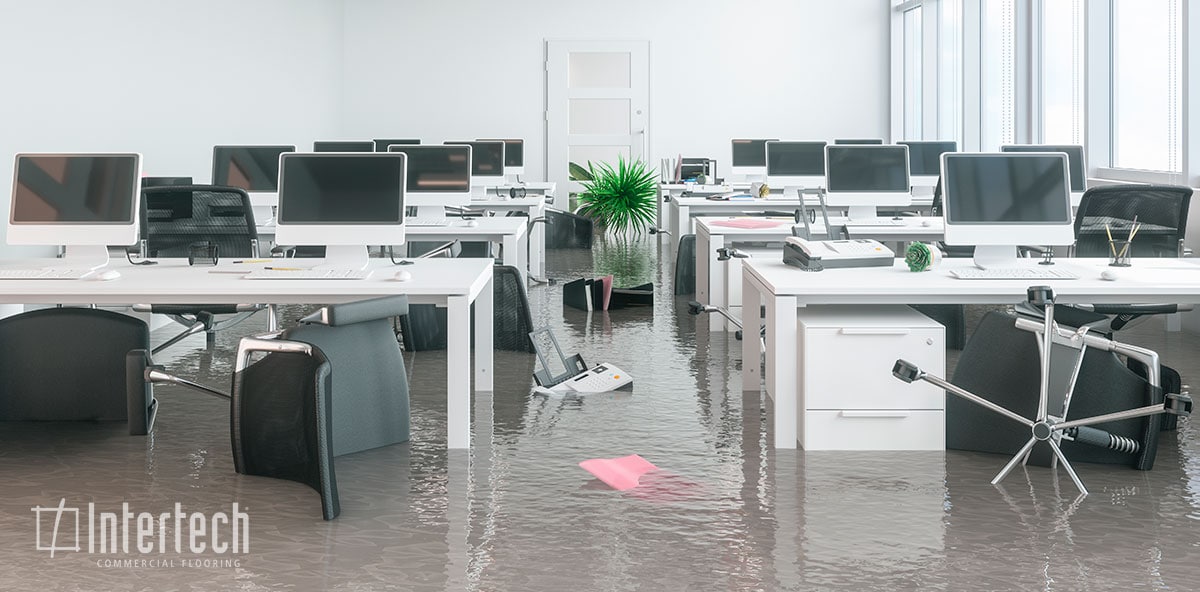
Water damage from freeze?
How to save your floors
Water damage can occur unexpectedly at any time … a winter freeze that burst pipes, a plumbing malfunction that floods offices, roof and window leaks from Austin’s sporadic rainstorms. Water-damaged floors cause costly work disruptions or stoppage and can create long-term repercussions if moisture mitigation isn’t handled promptly and professionally.
It’s been a couple of months since the brutal winter storm that paralyzed Texas for 10 days. Estimates are that losses from what’s been dubbed a “perfect storm” of freezing temps, ice and snow could top the insurance industry’s list of most expensive weather events ever.
Many of those businesses are still recovering and will be for some time. As building owners work to schedule repairs as quickly as possible, it’s important to not put speed over doing repairs the right way. In many cases, permanent repairs should be delayed until the building is completely dry — which can take weeks in some cases.
In the meantime, here’s a checklist of some do’s and don’ts to consider in addressing your building’s water damage.
Do look for mold
The presence of mold can pose certain health risks for your employees and customers. Left untreated, it can spread quickly throughout a building — turning what may have been an isolated issue into costly mitigation. Untreated moisture on subfloors can quickly become a breeding ground for mold.
Do look for other tell-tale signs of water damage
Make a room-by-room inspection of your building, ceiling to floor. Do you see any areas where drywall is swollen, laminate or wood flooring is pulling up or buckling or areas of carpeting that are discolored or soft? What about changes in paint color around baseboards or on ceilings? All of those could indicate the presence of moisture.
Do act quickly to address wet carpeting
Discard flooded carpeting and carpet pads. Dry any remaining carpet to remove any remaining dampness.
Don’t forget about subfloor
Plywood or OSB subfloors will separate or swell with moisture. Once floor coverings are removed, look for buckling or warping in your subfloors. Allow them to dry thoroughly, a process that can take months without a dehumidifier. Consider renting a commercial-grade dehumidifier — they come in a variety of types, from traditional condensate humidifiers to ones that rely on silica gel to pull water from the air.
Don’t focus just on carpeting
Floors with hard surface floor coverings are equally vulnerable to water damage. Water also can seep under laminate flooring and may require the removal of sections or the entire sheet. When left unaddressed, moisture damage can lead to extremely costly repairs and mitigation. Depending on the extent of the damage, consider hiring a flooring professional with moisture mitigation experience to inspect your wood flooring areas to assess potential damage and handle repairs.
Don’t try to do it all yourself
Rely on a flooring professional for advice on the best way to remove any damaged areas, which will depend on the type of material and adhesive. A small space with minimal moisture impact could potentially be corrected with in-house maintenance staff, but for larger areas or when in doubt, get a second or even third opinion on the moisture damage and best course for mitigation. Ask your contractors for references in which they successfully handled other moisture damage situations. A contractor may have years of experience in installing flooring, but have none in handling difficult moisture situations. You don’t want your project to be their learning experience.
Summary
While it may be time-consuming upfront, taking the time to assess and mitigate moisture damage is worth doing right the first time. Shortcuts to save time and money or work done by inexperienced contractors will likely end up costing you more money in the long run. Rely on a trusted flooring professional with experience in moisture mitigation to get your building’s flooring back to optimal health.
 Bill Imhoff is President/CEO of Intertech Flooring, leads three regional offices serving commercial clients across Texas and the Southwest.
Bill Imhoff is President/CEO of Intertech Flooring, leads three regional offices serving commercial clients across Texas and the Southwest.
This article was originally published in the Austin Business Journal and is used with permission. The original article can be found here. As an invited member of the Business Journal’s Leadership Trust, Bill provides thought-leadership content and advice to the Austin business community around his areas of expertise, including commercial flooring, entrepreneurship, leadership and workforce development.
Recent Posts
Need Samples?
Order from multiple vendors, all at once!
You’ve Got Better Things To Do...
Enjoy our one-stop approach to easy sample orders.